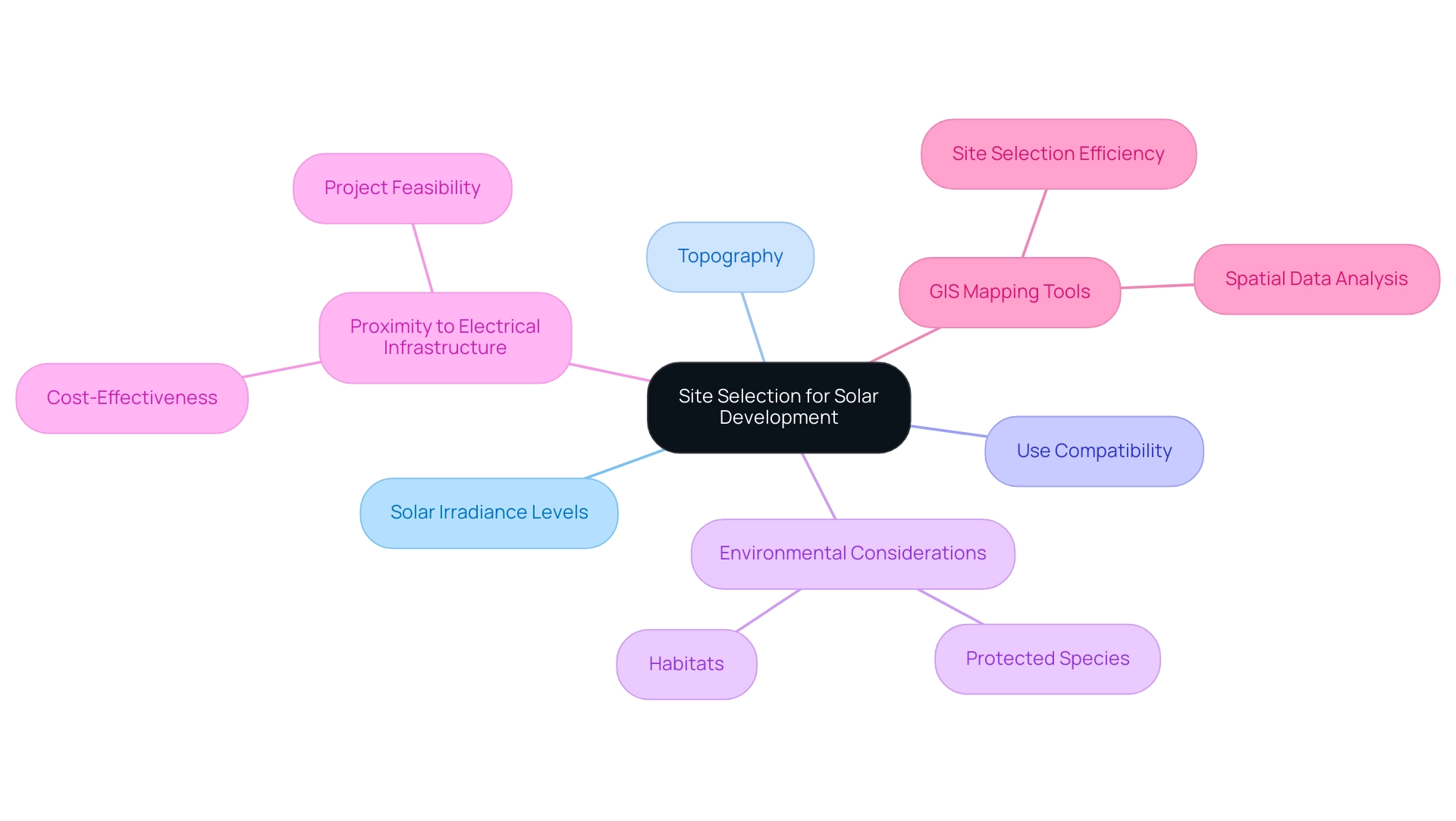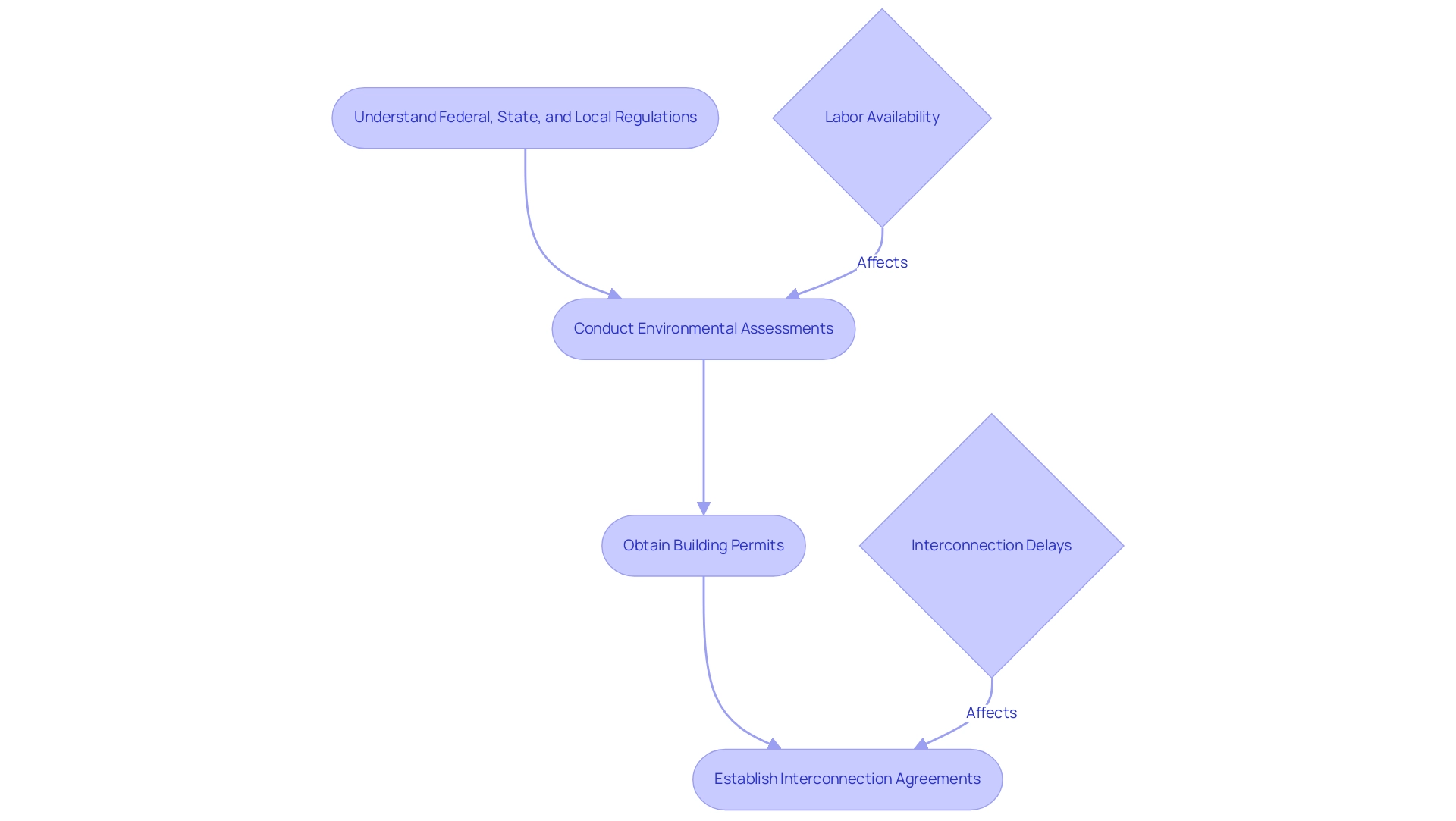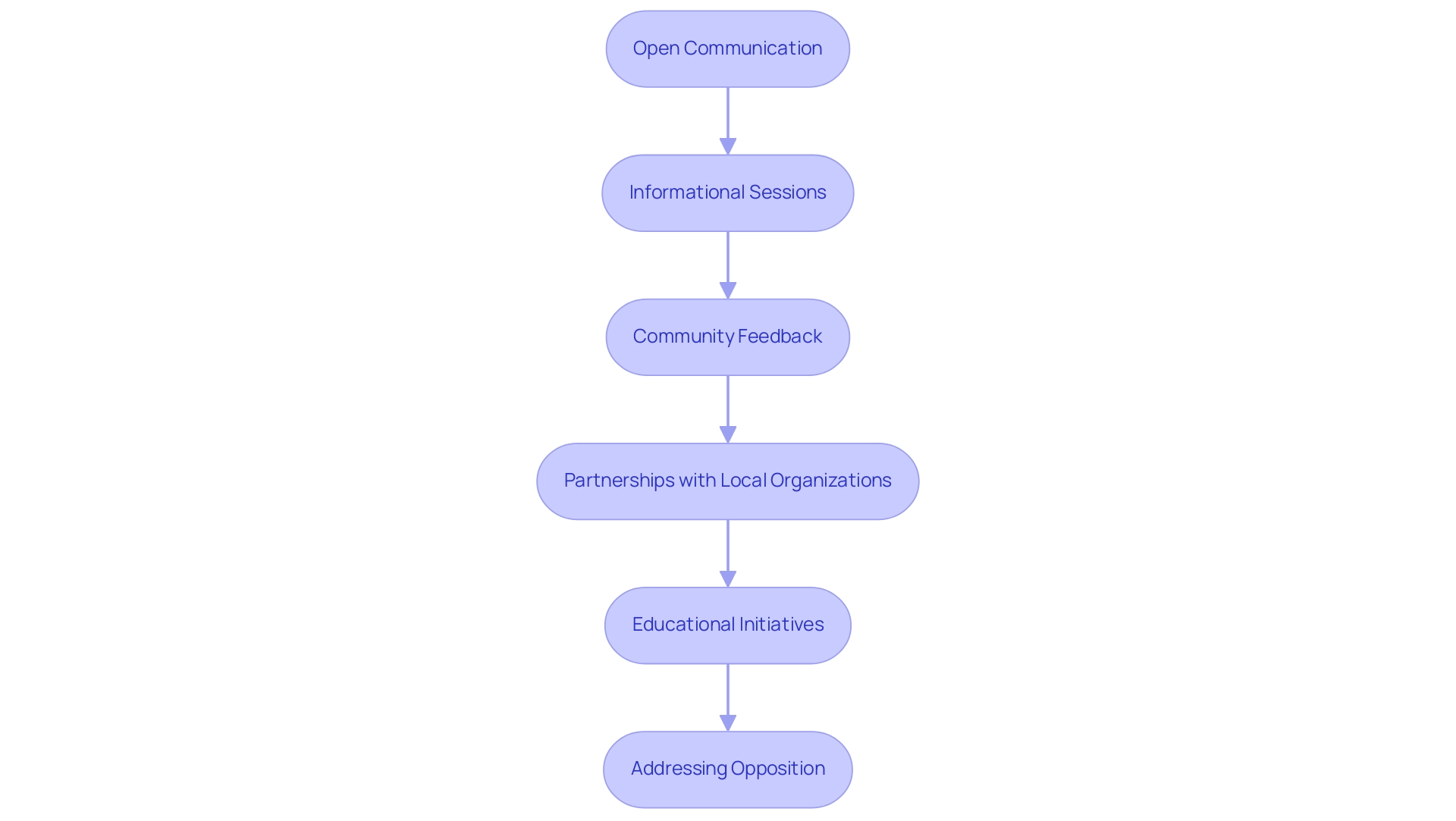Introduction
The rapid expansion of solar energy initiatives necessitates a comprehensive understanding of various factors influencing their successful implementation. From navigating the complexities of land leasing and site selection to addressing regulatory challenges and fostering community engagement, each element plays a critical role in shaping the future of solar development. As the demand for clean energy surges, developers must adeptly maneuver through technical, environmental, and economic considerations to maximize benefits for both stakeholders and local communities.
This article delves into the essential components of solar project development, offering insights into best practices that can enhance project viability and community acceptance while driving the transition to a sustainable energy landscape.
Understanding Land Leasing for Solar Projects
Careful navigation of several critical steps and considerations is essential in solar project land consulting for land leasing. Initially, developers must identify viable sites that meet both technical and environmental criteria. Once potential locations are pinpointed, the next phase of solar project land consulting involves negotiating lease terms with landowners.
Key aspects of this negotiation include:
- Understanding the lease duration, which typically ranges from 20 to 30 years.
- Establishing payment structures that reflect the value of the property and the expected production of power.
- Addressing any stipulations regarding use of the property, such as the allowance for agricultural activities or conservation efforts.
Significantly, utility-scale systems increasingly deliver hundreds of megawatts and span thousands of acres, emphasizing the importance of solar project land consulting in scaling solar energy initiatives. Documentation necessary for the leasing process generally includes:
- Lease agreements
- Comprehensive surveys
- Title reports to confirm ownership and any potential encumbrances
Thorough due diligence is essential to ensure that the site is suitable for development and that the lease aligns with anticipated timelines.
In recent studies, such as those conducted by the University of Illinois Chicago, research is being undertaken on the impacts of pollinator plantings at solar PV facilities. This study emphasizes the potential for dual use of terrain, which is further supported by NREL researcher Jordan Macknick's insights:
"The project team is researching simultaneously growing crops under PV arrays while producing electricity from the panels."
This highlights the benefits for both developers and property owners.
Consulting with experts in solar project land consulting can significantly facilitate the leasing process, as these professionals provide valuable insights into local practices and legal requirements. Their expertise can lead to more favorable lease terms and smoother negotiations, ultimately benefiting both developers and landowners. As demonstrated in the Solar Star Project, which has a capacity of 579 MW, successful lease negotiations established a benchmark for utility-scale photovoltaic developments, highlighting the crucial role of strategic leasing in the expansion of renewable initiatives.
Key Considerations for Site Selection in Solar Development
The choice of an optimal site for solar project land consulting includes a multifaceted evaluation of various factors, such as solar irradiance levels, topography, and use compatibility. In Mexico, for instance, only 0.1% of the country’s land area has the potential to generate enough power to meet existing energy demands, which underscores the importance of solar project land consulting for precise site evaluations. Environmental considerations play a critical role in solar project land consulting; developers must evaluate the presence of protected species and habitats to avoid regulatory complications.
Furthermore, the proximity to existing electrical infrastructure is a crucial determinant in solar project land consulting, as it affects project feasibility and cost-effectiveness. Conducting comprehensive environmental impact studies and adhering to local zoning regulations are essential steps in solar project land consulting to ensure compliance and mitigate potential risks. To enhance site selection efficiency in solar project land consulting, utilizing GIS mapping tools can provide valuable spatial data, enriching the decision-making process.
Resources such as the .Stat Data Explorer allow for data exports in Excel and CSV formats, enabling detailed analysis. The Global Solar Atlas functions as an online resource delivering the most recent information on renewable energy potential worldwide, accompanied by country factsheets for comparative analysis, assisting policymakers and investors in assessing energy potential in different regions. Moreover, IRENA’s dashboard provides electricity generation and capacity datasets from the year 2000 onward, which is beneficial for informed choices in solar project land consulting related to renewable investments.
As stated by the World Bank,
The World Bank is committed to supporting such countries in harnessing the opportunity for low-cost, clean solar power in a way that supports economic development and job creation.

Economic and Community Benefits of Solar Projects
Solar initiatives provide significant economic benefits that go beyond simple power generation, especially regarding job creation during both the construction and operational stages. A notable statistic indicates that in 2023, the installation and development sector alone added 7,254 jobs, highlighting the industry's strong growth. To provide historical context, it is worth noting that in 2010, the solar power sector employed 93,502 individuals, highlighting the significant expansion over the years.
Furthermore, local communities reap benefits from increased tax revenues derived from these projects, which can be allocated to enhance public services and improve infrastructure. The positive economic impact is further amplified by promoting independence in resources and stabilizing local costs. As AFL-CIO President Liz Shuler highlights,
Thanks to the Biden-Harris administration's historic investments, clean energy jobs are booming in every single state.
This statement reinforces the notion that engaging local stakeholders should involve framing renewable energy initiatives as key opportunities for community development. Furthermore, the Jobs Census classifies renewable energy positions by sector, showing that installation and development companies account for almost two-thirds of all renewable energy jobs, which demonstrates the varied opportunities accessible. Sharing case studies from similar successful initiatives can effectively illustrate these potential benefits, thereby fostering community support and trust in the effort.
Lastly, understanding the levelized cost of PV electricity in the U.S. by capacity for 2014 can further emphasize the economic viability and attractiveness of investments in this energy source.
Navigating Regulatory and Permitting Challenges
Navigating the regulatory and permitting landscape for renewable energy projects, particularly in the realm of solar project land consulting, requires a nuanced understanding, as challenges can differ significantly based on location and the scale of the installation. Developers must familiarize themselves with a complex array of federal, state, and local regulations that govern energy systems. Notably, the demand for skilled professionals in the renewable energy sector has surged, with US green job postings growing 20% in 2022, while the growth of green talent only reached 8.4%.
This discrepancy highlights the increasing need for expertise in navigating regulatory challenges. Commonly required elements in solar project land consulting include:
- Environmental assessments
- Building permits
- Interconnection agreements with utility providers
Each of which plays a critical role in the initiative's progression. A recent case study indicates that the utility-scale solar sector achieved its strongest third quarter on record in Q3 2024, with 6.6 GW installed, representing a 44% year-over-year growth.
However, challenges such as labor availability and interconnection delays may impact future growth. Engaging proactively with local government entities at the outset can help identify potential hurdles early in the solar project land consulting process, thereby streamlining approvals. Maintaining detailed records of all communications and acquired permits not only aids compliance checks and inspections but also creates a strong portfolio that can be advantageous for future endeavors.
As The Hamilton Project and Energy Policy Institute highlight, effective policy tools are crucial in addressing the economic implications of climate change. Staying informed about the latest regulatory challenges for 2024 is essential for successful execution.

Engaging Communities for Successful Solar Development
Effective community engagement hinges on the principles of open communication and transparency. Developers are encouraged to arrange informational sessions that inform community members about the advantages while addressing their concerns. Involving the community during the planning stage not only encourages valuable feedback but also aligns the initiative more closely with local needs.
Forming partnerships with local organizations boosts credibility and encourages goodwill, making the initiative's presence more acceptable. As highlighted in the report 'Community Power: Jobs and Savings for LMI Households,' initiatives like the Santa Rosa Community Solar Initiative and the White Marsh Community Solar Farm effectively collaborate with nonprofit organizations to support engagement and outreach to community members. For example, the Heart Butte Community Solar project effectively combined educational initiatives by partnering with a local science instructor to develop renewable resource challenges for students.
This method not only offered students practical training but also extended the advantages of community energy subscriptions to their families. Furthermore, developers should proactively prepare to address potential opposition by clearly articulating the long-term advantages of renewable sources for the community, including its environmental benefits and the economic opportunities it presents. Notably, anchor tenants typically subscribe to a large share of the energy produced by the project, sometimes up to 40-50% of the total project capacity, illustrating the significant impact of community energy initiatives on local engagement.
The North Carolina Solar Program (NCSP) guide, produced by CESA with support from the U.S. Department of Energy, underscores best practices for community engagement in solar development, with updates expected from the 2023 Sunny Awards in 2024, further reinforcing the relevance of these strategies.

Conclusion
The successful implementation of solar energy initiatives relies heavily on strategic planning and community involvement. Key considerations such as:
- Land leasing
- Site selection
- Navigating regulatory challenges
are critical for developers aiming to maximize the potential of solar projects. Understanding the complexities of land agreements, including lease terms and dual land use, can significantly impact project feasibility and community acceptance.
Moreover, site selection must be approached with a comprehensive assessment of environmental factors and proximity to existing infrastructure. Utilizing advanced tools such as GIS mapping can enhance decision-making, ensuring that chosen sites align with both technical requirements and community needs. The economic benefits of solar projects further underscore their importance, as evidenced by job creation and increased tax revenues that bolster local economies.
Engaging communities throughout the development process is equally vital. Open communication and partnership with local organizations foster trust and support, allowing projects to align more closely with community interests. By addressing concerns and highlighting the long-term benefits of solar energy, developers can cultivate a favorable environment for project acceptance.
In conclusion, the future of solar energy development hinges on a multifaceted approach that integrates technical, economic, and social dimensions. As the demand for clean energy continues to grow, embracing best practices in project development will not only enhance viability but also ensure that the transition to sustainable energy serves the interests of all stakeholders involved. The commitment to transparency, community engagement, and strategic planning will ultimately shape a successful path forward in the solar energy landscape.
Frequently Asked Questions
What are the first steps in solar project land consulting for land leasing?
The initial steps involve identifying viable sites that meet both technical and environmental criteria before negotiating lease terms with landowners.
What key aspects should be considered during lease negotiations in solar project land consulting?
Key aspects include understanding the lease duration (typically 20 to 30 years), establishing payment structures based on property value and expected power production, and addressing stipulations regarding property use, such as agricultural activities or conservation efforts.
Why is thorough due diligence important in the leasing process?
Thorough due diligence ensures that the site is suitable for development and that the lease aligns with anticipated timelines, minimizing potential risks.
What documentation is generally necessary for the solar leasing process?
Necessary documentation typically includes lease agreements, comprehensive surveys, and title reports to confirm ownership and identify any potential encumbrances.
How does solar project land consulting contribute to the development of renewable energy initiatives?
Solar project land consulting plays a crucial role in scaling solar energy initiatives by facilitating strategic leasing, which can lead to more favorable lease terms and smoother negotiations, benefiting both developers and landowners.
What environmental factors must developers consider during site evaluation?
Developers must evaluate the presence of protected species and habitats, proximity to existing electrical infrastructure, and conduct comprehensive environmental impact studies while adhering to local zoning regulations.
How can GIS mapping tools enhance site selection in solar project land consulting?
GIS mapping tools provide valuable spatial data that enriches the decision-making process, improving the efficiency of site selection.
What resources are available for analyzing renewable energy potential in different regions?
Resources include the Global Solar Atlas for recent renewable energy information, IRENA’s dashboard for electricity generation and capacity datasets, and the .Stat Data Explorer for detailed data analysis.
What is the significance of the Solar Star Project in the context of solar project land consulting?
The Solar Star Project, with a capacity of 579 MW, demonstrates successful lease negotiations that established benchmarks for utility-scale photovoltaic developments, highlighting the importance of strategic leasing in renewable energy expansion.
List of Sources
- Understanding Land Leasing for Solar Projects
- Utility-Scale Solar Continues to Grow in the US in 2024 (https://landgate.com/news/utility-scale-solar-continues-to-grow-in-the-us-in-2024)
- Community Solar – SEIA (https://seia.org/initiatives/community-solar)
- Farmer's Guide to Going Solar (https://energy.gov/eere/solar/farmers-guide-going-solar)
- Utility-Scale Solar Power Facts | ACP (https://cleanpower.org/facts/solar-power)
- Key Considerations for Site Selection in Solar Development
- Solar Photovoltaic Power Potential by Country (https://worldbank.org/en/topic/energy/publication/solar-photovoltaic-power-potential-by-country)
- Renewable Energy Progress Tracker – Data Tools - IEA (https://iea.org/data-and-statistics/data-tools/renewable-energy-progress-tracker)
- Renewable energy statistics 2024 (https://irena.org/Publications/2024/Jul/Renewable-energy-statistics-2024)
- Economic and Community Benefits of Solar Projects
- DOE Report Shows Clean Energy Jobs Grew at More Than Twice the Rate of Overall U.S. Employment (https://energy.gov/articles/doe-report-shows-clean-energy-jobs-grew-more-twice-rate-overall-us-employment)
- Census Solar Job Trends (https://irecusa.org/census-solar-job-trends)
- U.S:. solar energy jobs 2023 | Statista (https://statista.com/statistics/208252/projected-number-of-solar-energy-related-jobs-in-the-us)
- Navigating Regulatory and Permitting Challenges
- 2025 Renewable Energy Industry Outlook (https://www2.deloitte.com/us/en/insights/industry/renewable-energy/renewable-energy-industry-outlook.html)
- Solar Market Insight Report Q4 2024 – SEIA (https://seia.org/research-resources/solar-market-insight-report-q4-2024)
- Eight facts about permitting and the clean energy transition - The Hamilton Project (https://hamiltonproject.org/publication/economic-fact/eight-facts-permitting-clean-energy-transition)
- Engaging Communities for Successful Solar Development
- Community Solar Best Practices Guide: Developing Projects with Meaningful Benefits (https://energy.gov/communitysolar/community-solar-best-practices-guide-developing-projects-meaningful-benefits)
- Community Outreach and Solar Equity: A Guide for States on Collaborating with Community-Based Organizations - Clean Energy States Alliance (https://cesa.org/resource-library/resource/community-outreach-solar-equity)




